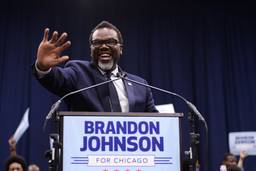
Establishment politicians and strategists in the Democratic Party have long fixated on the necessity of winning the swing vote. And there’s one principal way they believe such swing voters can be won over: by moving rightward.
These Dems would love nothing more, they assure us, than to put forward a bold, progressive agenda — but, they explain, “electability” requires we listen to a small but mighty group of swing voters who make up the margin of victory, and who will run into the GOP’s arms if spooked by policies they consider too radical. So don’t scare them: Split the difference between what you really believe and whatever barbarities Republicans are advocating, and keep your policy proposals safe and centrist.
But this logic has been proven spectacularly wrong, as recently as 2016.
The centrist argument for Hillary Clinton in 2016 was that, while she may have been compromised by her political history of pro-corporate and pro-war policies, her political “moderation” would endear her to swing voters who would spare us a President Donald Trump.
Democratic Sen. Chuck Schumer (N.Y.) foresaw the possibility of a depressed voter base as a result of a rightward party shift, but predicted it wouldn’t matter. “For every blue-collar Democrat we lose in western Pennsylvania, we will pick up two moderate Republicans in the suburbs in Philadelphia,” he claimed. But the results didn’t work that way.
In Milwaukee’s poorest neighborhoods, for example — most of which are majority black, a demographic Democrats take for granted — turnout between 2012 and 2016 dropped significantly more than the rest of Wisconsin, helping deliver the state to Trump by only 23,000 votes. In Michigan, 87,810 people voted without choosing anyone for president — twice as many as 2012 — and Trump won the state by less than 11,000 votes.
The 2016 result does seem to have changed the consensus on swing voters among some mainstream political analysts. Rachel Bitecofer, for example, a political scientist and fellow at the centrist think tank Niskanen Center, tells Politico that she is in favor of “flipping giant paradigms of electoral theory upside down” by ignoring swing voters.
For one thing, there aren’t that many of them. Conventional wisdom puts the number of swing voters around 15 – 20% of the electorate, but Bitecofer argues it’s more like 6 – 7%. The actual swing voters to pay attention to, she says, are not those swinging between parties, but those swinging between voting or staying home.
The typical Left argument, instead, is to simply focus on activating the Democratic base. Offer something exciting to vote for, like a progressive platform, and they will show up. Those voters in Milwaukee and Michigan, and other dejected voters around the country, might have voted for a Democrat with a more inspiring platform. By running a principled campaign on policies that actually benefit the working class — rather than kowtowing to the center — we can excite the base while still winning over moderates and even conservatives. It’s a key insight of the Sanders 2020 campaign. Sanders has not campaigned to be all things to all swing voters. Instead, he has called for a “political revolution” to liquidate the private health insurance industry and end the crushing burden of student loan debt for millions. And he has insisted that workers themselves be the ones to win that revolution, summed up pithily in his campaign slogan, “Not me, us.” That strategy is far from guaranteed to win and has not been uniformly successful, but the signs are promising. Sanders became the first candidate to ever win the popular vote in all three early voting states, Iowa, New Hampshire and Nevada. And he has the highest favorability rating of any Democratic primary candidate.
In Nevada, according to entrance polls, Sanders won 50% of Latinos, a plurality of whites, a strong 28% of black voters, a majority of Independents, a majority or plurality of all age categories between 17-64, and, incredibly, a 23% plurality of self-identified moderate or conservative voters. Combined with poll data from around the country, the results indicate Sanders is assembling a broad and potentially winning coalition, all without playing to the center.
The swing-voter strategy that marginalizes progressive policy is a strategic dead end (to say nothing of being morally bankrupt) and should be abandoned. But that doesn’t mean we can’t win over voters beyond “the base.” The Left represents a politics that benefits the majority, not the few— and if we run on that, we can win that majority.
For a response to this piece, see Dan Cohen’s article, “The 7% Matter.”
Views expressed are the author’s. As a 501©3 nonprofit, In These Times does not support or oppose any candidate for public office.
Micah Uetricht is an editor at Jacobin magazine. He is a contributing editor and former associate editor at In These Times, and the author of Strike for America: Chicago Teachers Against Austerity and coauthor of Bigger Than Bernie: How We Go From the Sanders Campaign to Democratic Socialism, and is currently at work on a book on New Leftists who took jobs in industries like steel and auto to organize on the shop floor.









